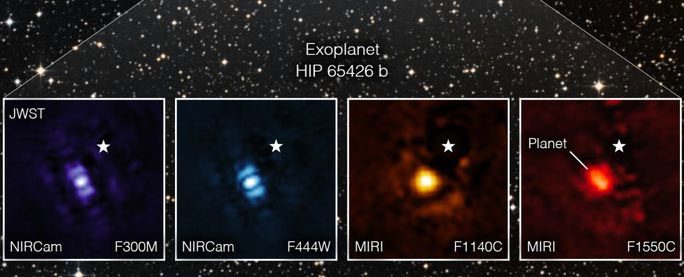The James Webb Space Telescope, which astronomers hoped would be capable of directly observing worlds with potential life, has proven to meet expectations: it has returned the first direct images of an exoplanet.
The images of exoplanets—planets outside our Solar System—that we have seen previously were all graphic representations based on rare spectral data collected by telescopes from the “light curve” of the parent star, when the planet happened to transit the space between the star and Earth. This is due to their immense distances.
However, in a study published online on arXiv on September 2, a group of scientists identified the first direct image of an exoplanet in the data sent back to Earth by the James Webb Space Telescope.

The first direct portrait of an exoplanet captured by humanity through four different filters – (Photo: NASA/ESA/CSA/UCSC/STScI).
The James Webb is a $9 billion telescope primarily operated by NASA, in collaboration with ESA and CSA (the European and Canadian space agencies), and has been operational for several months now.
In addition to its main mission of observing deep space to identify intriguing objects in the universe, it was also expected to utilize its “all-seeing eye” to look into worlds where preliminary data previously suggested the possibility of life.
The groundbreaking images analyzed by a team of scientists led by astrophysicist Sahaa Hinkley from the University of Exeter in the UK and astronomer Aarynn Carter from the University of California, Santa Cruz, have demonstrated that if there is an “alien home” out there, James Webb would capture it.
Through four different filters, the planet named HIP 65426b, located 350 light-years away, appears quite faint, but for scientists, this is enough to provide a wealth of data.
This extraordinary observation once again confirms the ability to capture chemical signatures of compounds related to life that may exist in the atmosphere of the exoplanet. This is what astrobiologists are searching for, rather than a literal portrait of an alien.
HIP 65426b was first discovered in 2017 using a tool called SPHERE mounted on the Very Large Telescope of the European Southern Observatory (ESO), with a mass 7.1 times that of Jupiter.
“Obtaining this image feels like we are uncovering a treasure in space. I think the most exciting part is that we are just getting started. There are many images of exoplanets waiting to be discovered, helping us to gain a comprehensive understanding of their physics, chemistry, and formation,” said Dr. Carter.


















































